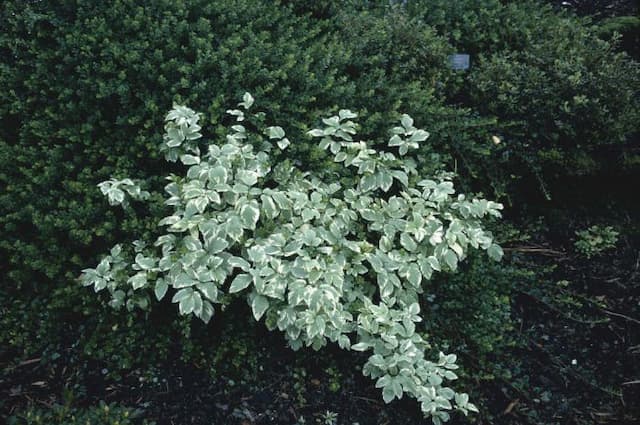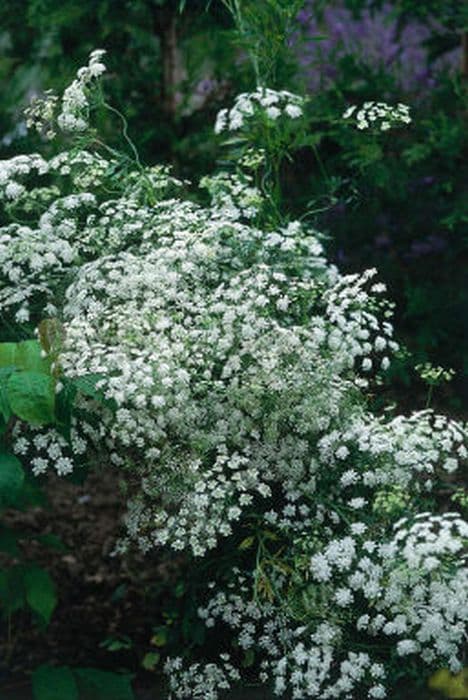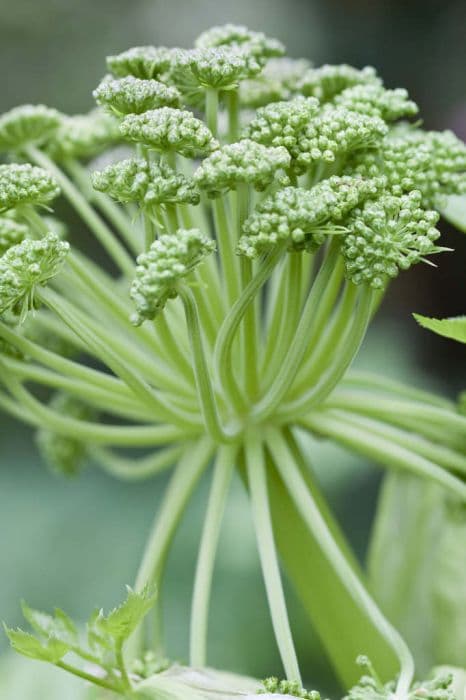Lesser masterwort Astrantia minor

ABOUT
Astrantia minor, commonly known as lesser masterwort, is a charming plant characterized by its delicate features and unique flower structure. This plant typically has a basal rosette of deeply lobed, palmate leaves that are green with a slightly rough texture. The flower of the lesser masterwort is its most distinctive feature, consisting of an umbel of tiny, star-shaped blossoms that create a pincushion effect. These flowers are usually a soft, subtle shade of pink or white and can sometimes have a hint of green. Each individual flower is intricate, with a ruff of bract-like petals surrounding it that may have a papery texture, providing a striking contrast to the more vivid central florets. The stems of the lesser masterwort are slender and branched, rising above the foliage and carrying the complex flower heads to make them prominent. The overall impression of the plant is one of delicate beauty and fine texture, often contributing to a cottage garden aesthetic or being used as a filler in floral arrangements. The plant can carry a certain whimsy, thanks to its star-like flowers, which seem to float above the green, dissected leaves.
About this plant
 Names
NamesSynonyms
Lesser Masterwort
Common names
Astrantia minor
 Toxicity
ToxicityTo humans
Astrantia minor, commonly known as lesser masterwort, is not widely recognized for its toxicity to humans. There is limited information on the toxic properties of this plant when it comes to human ingestion, and it is not typically regarded as a poisonous plant. Therefore, there aren't well-documented symptoms of poisoning specific to lesser masterwort. However, as with any plant, individual allergies or sensitivities may exist, and ingesting any part of a plant not commonly used for food could potentially cause adverse reactions in some individuals.
To pets
Lesser masterwort, or Astrantia minor, does not have a well-documented history of toxicity in pets either. There is limited information available regarding its effects on animals, and it is not commonly listed as a toxic plant to pets such as dogs and cats. However, as with human consumption, it's always prudent to be cautious and prevent pets from ingesting plants that are not part of their regular diet, as individual animals may have specific sensitivities or reactions.
 Characteristics
CharacteristicsLife cycle
Perennials
Foliage type
Deciduous
Color of leaves
Green
Flower color
Varies
Height
1-2 feet (30-60 cm)
Spread
1-2 feet (30-60 cm)
Plant type
Herb
Hardiness zones
5
Native area
Europe
Benefits
 General Benefits
General Benefits- Ornamental Value: Astrantia minor, commonly known as great masterwort, features distinctive pincushion-like flowers that add a unique aesthetic to gardens and floral arrangements.
- Attracts Pollinators: The flowers of the great masterwort are known to attract bees, butterflies, and other beneficial insects, supporting local biodiversity.
- Drought Tolerance: Once established, Astrantia minor is relatively drought-resistant, making it suitable for gardens in drier climates or for water-wise landscaping.
- Shade Tolerance: Great masterwort can thrive in partially shaded areas where other plants might struggle, providing gardeners with flexible planting options.
- Long Blooming Period: The plant has a long flowering season, which can extend from late spring into late summer, offering visual interest for an extended period.
- Low Maintenance: Astrantia minor does not require extensive care and is relatively easy to grow, making it ideal for both novice and experienced gardeners.
- Herbaceous Perennial: As a perennial plant, it will return year after year, providing a reliable presence in a perennial border or garden design.
- Cut Flowers: The blooms of great masterwort make excellent cut flowers, lasting well in vases and adding a rustic charm to indoor bouquets.
- Deer Resistance: The plant is not particularly palatable to deer, reducing the risk of damage in areas where deer browsing can be a problem for gardens.
 Medical Properties
Medical PropertiesThis plant is not used for medical purposes.
 Air-purifying Qualities
Air-purifying QualitiesThis plant is not specifically known for air purifying qualities.
 Other Uses
Other Uses- Dye Production: The roots of Astrantia minor can be used to produce a natural red dye for coloring fabrics and textiles.
- Decorative Art: Pressed flowers of Astrantia minor can be used in decorative art pieces, such as botanical prints or herbarium collections.
- Culinary Garnish: Although not widely known, the flowers and young leaves may be used as a garnish for salads and desserts to add a touch of elegance.
- Floral Arrangements: Astrantia minor is popular among florists for its unique star-shaped blooms and is often used in bouquets and floral decorations.
- Photography Prop: The intricate structure of Astrantia minor flowers makes them a popular choice as a subject for macro and nature photography.
- Garden Design: Used as a 'filler' plant, Astrantia minor can provide a textured backdrop for other flowers in garden beds and borders.
- Education: Botany students may study Astrantia minor for its distinct characteristics as a representative of the Apiaceae family.
- Eco-Friendly Confetti: Dried petals of Astrantia minor can be used as a biodegradable alternative to traditional paper confetti at events.
- Companion Planting: Astrantia minor may be planted among vegetables to help attract beneficial insects and pollinators to the garden.
- Craft Projects: The seeds and dried flower heads can be used in craft projects, such as making natural jewelry or embellishments.
Interesting Facts
 Feng Shui
Feng ShuiThe plant Astrantia is not used in Feng Shui practice.
 Zodiac Sign Compitability
Zodiac Sign CompitabilityThe plant Astrantia is not used in astrology practice.
 Plant Symbolism
Plant Symbolism- Grace and Elegance: Astrantia minor, commonly known as Great Masterwort, often symbolizes grace and elegance due to its intricate star-like bracts and delicate appearance.
- Mystery and Magic: The plant's unique form and the ability to thrive in shady areas have associated it with elements of mystery and enchantment in the garden.
- Protection: In traditional herbology, Great Masterwort was believed to possess protective properties, and thus it also symbolizes safety and defense.
- Strength in Adversity: Great Masterwort's ability to grow in difficult conditions is seen as a symbol of resilience and strength in the face of challenges.
 Water
WaterMasterwort prefers consistently moist soil, so it's best to water it deeply whenever the top inch of soil feels dry to the touch, usually about once or twice a week depending on the climate and weather conditions. During the growing season in spring and summer, you might find that watering with approximately 1 to 2 gallons per week will suffice. It's important not to let the soil dry out completely, but also to avoid waterlogging. Ensure that the plant has good drainage to prevent root rot. In winter, reduce watering to match the plant's dormant state and lower evaporation rates.
 Light
LightMasterwort thrives in partial shade to full sun conditions. However, in hotter climates, it will benefit from being placed in a location where it can receive dappled sunlight or afternoon shade. A spot that enjoys morning sun and is protected from the intense midday sun is ideal for this plant. Avoid deep shade as this can result in fewer flowers and leggy growth.
 Temperature
TemperatureMasterwort is hardy and can endure a range of temperatures, making it quite resilient. It can survive in temperatures as low as 25 degrees Fahrenheit, and as high as 80 degrees Fahrenheit without significant stress. The ideal temperature range for thriving growth is between 60 to 75 degrees Fahrenheit. For optimal health, avoid exposing the plant to extreme heat or cold for prolonged periods.
 Pruning
PruningMasterwort should be pruned to remove spent flowers, which encourages additional blooming and prevents the plant from self-seeding excessively. Also, pruning in late winter or early spring, just before new growth begins, can help maintain a tidy shape and promote vigorous growth. Dead or damaged stems should be cut back to the base of the plant to maintain its health and appearance. Pruning can be done annually or as needed throughout the growing season to remove dead stems.
 Cleaning
CleaningAs needed
 Soil
SoilLesser masterwort (Astrantia minor) thrives best in a soil mix composed of loamy, well-draining soil with a good amount of organic matter. Aim for a soil pH between 5.5 and 7 to meet the plant's acidic to neutral preference. A blend of garden soil, compost, and perlite or sand to improve drainage is ideal for this plant. Regularly adding organic matter will help maintain the soil fertility and structure suitable for lesser masterwort.
 Repotting
RepottingLesser masterwort typically does not require frequent repotting and can usually be left undisturbed for several years. It is generally recommended to repot or divide the clumps every 3 to 4 years to rejuvenate the soil and give the plants space to grow. The best time to repot or divide is in the early spring or fall.
 Humidity & Misting
Humidity & MistingLesser masterwort prefers a moderately humid environment, similar to its native woodland habitat. While it does not demand high humidity, maintaining average room humidity is usually sufficient. If the air is too dry, especially during winter months indoors, you might consider using a humidifier or placing a tray of water near the plant to raise the moisture level in the air around it.
 Suitable locations
Suitable locationsIndoor
Place in bright, indirect light and water when topsoil is dry.
Outdoor
Plant in partial shade, enriched, moist soil, and mulch annually.
Hardiness zone
5-7 USDA
 Life cycle
Life cycleAstrantia minor, commonly known as Lesser masterwort, begins its life cycle as a seed that germinates in moist, fertile soil, typically in the spring. Once the seedling emerges, it develops a rosette of leaves at the soil surface. As it matures, the plant produces a sturdy stem and a cluster of star-like flowers typically in the summer, which are hermaphroditic and can attract a range of pollinators, including bees. Following pollination, the flowers give way to seed heads that eventually dry and release seeds to the surrounding environment. The plant is perennial, meaning once it reaches maturity, it can survive through multiple seasons, dying back to the root system during winter and re-sprouting in subsequent springs. Over time, Astrantia minor may also spread vegetatively through its rhizome, forming clumps and expanding its growth area.
 Propogation
PropogationPropogation time
Spring to early summer
The most popular method of propagation for Astrantia minor, commonly known as Lesser Masterwort, is by division. This process is typically undertaken in either the spring or autumn. Dividing the plant involves carefully lifting it from the soil and separating the clump into smaller sections by either gently teasing the roots apart or using a sharp knife to slice through the plant base. Each divided section should have a portion of the root system and several shoots or buds. These divisions can then be immediately replanted into well-prepared soil, ensuring they are spaced properly to accommodate future growth. Watering the new plants thoroughly after planting helps establish them in their new location.









